Featured Exhibits
Sign up for the Newsletter
Advertise on ParachuteHistory.com
Disclaimer
Privacy Policy
About
Historical Review
Excerpt from Sandia Report SAND85-1180"An Introduction to Deployable Recovery Systems"
by Jan Meyer
August 1985
 The first known written account of a parachute concept is found in da Vinci's notebooks (cl495). The sketch he drew consisted of a cloth material pulled tightly over a rigid pyramidal structure. Although da Vinci never made the device, he is given credit for the concept of lowering man to the earth safely using a maximum drag decelerator.
The first known written account of a parachute concept is found in da Vinci's notebooks (cl495). The sketch he drew consisted of a cloth material pulled tightly over a rigid pyramidal structure. Although da Vinci never made the device, he is given credit for the concept of lowering man to the earth safely using a maximum drag decelerator.
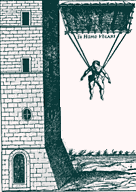 Fauste Veranzio constructed a device similar to da Vinci's drawing and jumped from a tower in Venice in 1617. Over a century would pass before further developments would be made by the famous balloonists, Joseph and Jacques Montgolfier. In 1783 they succeeded in lowering animals to the ground from rooftops or balloons. During the same year Sebastian Lenormand jumped from a tower using a 14-foot diameter parachute. The first emergency use of a parachute was made by Jean Pierre Blanchard in 1785 after the hotair balloon he was in exploded. Blanchard also worked on a foldable silk parachute, for until then all parachutes were constructed with a rigid frame.
Fauste Veranzio constructed a device similar to da Vinci's drawing and jumped from a tower in Venice in 1617. Over a century would pass before further developments would be made by the famous balloonists, Joseph and Jacques Montgolfier. In 1783 they succeeded in lowering animals to the ground from rooftops or balloons. During the same year Sebastian Lenormand jumped from a tower using a 14-foot diameter parachute. The first emergency use of a parachute was made by Jean Pierre Blanchard in 1785 after the hotair balloon he was in exploded. Blanchard also worked on a foldable silk parachute, for until then all parachutes were constructed with a rigid frame.
In 1797, Andrew Garnerin made the first jump with a parachute without a rigid frame. One of Garnerin's balloon jumps from 8000 feet, a very high altitude for the time, was observed by a French astronomer, Lalandes. As the parachute descended, severe oscillations were induced in the canopy. Lalandes suggested cutting a small hole near the apex of the canopy to inhibit the oscillations. This modification is now known as the vent and does indeed dramatically reduce canopy oscillations.
During the next century, parachute use was confined to carnivals and daredevil acts. Acrobats would perform stunts on a trapeze bar suspended from a descending parachute. The parachute was released from a hot-air balloon by attaching the top of the parachute to the equator of the balloon with a cord that broke after a person jumped from the basket. Public opinion became very unfavorable towards the use of parachutes when Robert Cocking fell to his death in 1837. Cocking jumped an inverted coneshaped parachute (point down) from 5000 ft. and distinguished himself by becoming parachuting's first fatality.
The next major contribution to parachute systems was the development of a harness by Captain Thomas Baldwin in 1887. The concept of folding or packing the parachute in a knapsak-like container was developed by Paul Letteman and Kathchen Paulus in 1890. Kathchen Paulus also demonstrated an intentional breakaway. After a first parachute inflated, it was released and pulled open a second parachute.
The first jump from an airplane has been claimed by both Grant Morton and Captain Albert Berry in 1911 or 1912. Morton jumped with a silk parachute folded in his arms which he threw out as he left the plane. Captain Berry had a 36 ft. parachute packed into a metal case beneath the fuselage. The parachute had a trapeze bar for him to hold on to as he jumped and descended to the ground. Also in 1911, an Italian, Pino, invented the pilot chute or drogue chute.' He attached a small parachute with a rigid frame to his helmet. The pilot chute would easily inflate, pull the helmet off and then pull the parachute out into the airstream.
The first freefall jump was made by Georgia "Tiny" Broadwick in 1914, but the military still did not believe that the human body could tolerate the experience of freefall for more than a few seconds before "blacking out." The skeptics were convinced in 1919 by Leslie Irvin and Floyd Smith. They demonstrated freefall jumps and developed the ripcord at the parachute testing and training center at Wright Field, established in 1918.
From World War I to the early 1930's, conventional round silk (now known as solid cloth) parachutes remained unchanged in structure. They were primarily used by military air corps in Europe, Russia, and the United States. During the 1930's Germany's Luftwaffe established the essential ingredients for air supremacy. Kurt Student conceived and implemented a rapid deployment strike force by parachuting men, equipment, and weapons from gliders and aircraft, such as the Junker JU52/3m. Germany demonstrated the effectiveness of airborne troops delivered to the battle scene by parachutes during World War II.

The development of modern parachutes deployed at high speeds and high altitudes started in the 1930's. Knacke and Madelung developed the ribbon parachute in Germany for 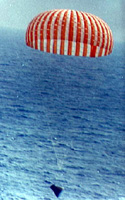 decelerating heavy high speed payloads. After World War 11 Knacke invented the ring slot parachute which is used for moderate subsonic speeds. This parachute is used primarily for cargo delivery and aircraft deceleration. The ring slot parachute is significantly cheaper to manufacture than the ribbon parachute.
The ring sail parachute, developed by Ewing, is used to decelerate payloads at low to moderate subsonic deployments speeds. The ring sail parachute was used as the final stages of the Mercury, Gemini, and Apollo projects because of its slow inflation rate and stability.
decelerating heavy high speed payloads. After World War 11 Knacke invented the ring slot parachute which is used for moderate subsonic speeds. This parachute is used primarily for cargo delivery and aircraft deceleration. The ring slot parachute is significantly cheaper to manufacture than the ribbon parachute.
The ring sail parachute, developed by Ewing, is used to decelerate payloads at low to moderate subsonic deployments speeds. The ring sail parachute was used as the final stages of the Mercury, Gemini, and Apollo projects because of its slow inflation rate and stability.

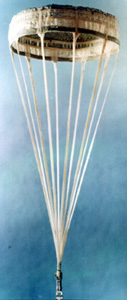 H. G. Heinrich invented the guide surface parachute (left) used as a pilot chute or for vehicle stabilization in the supersonic (to Mach 3) deployment regime. The hyperflo parachute (right) developed by Sims, is used as a hypersonic pilot chute for the Mach 1 to Mach 5 speed domain. The specific construction details of these modern high speed parachutes may be found in the Recovery Systems Design Guide.
H. G. Heinrich invented the guide surface parachute (left) used as a pilot chute or for vehicle stabilization in the supersonic (to Mach 3) deployment regime. The hyperflo parachute (right) developed by Sims, is used as a hypersonic pilot chute for the Mach 1 to Mach 5 speed domain. The specific construction details of these modern high speed parachutes may be found in the Recovery Systems Design Guide.
 The development of sport parachutes beyond solid cloth parachutes began in the early 1960's. Solid cloth parachutes were modified with drive slots that provide greater stability and horizontal speed. A class of sport parachutes, known as high performance rounds, includes Piglets, Paracommanders, Sierras, and Papillon parachutes. Piglets are similar to modified solid cloth parachutes, but are constructed from less porous material than solid cloth parachutes. Piglet parachutes are much smaller and much more reliable than solid cloth parachutes. The other three high performance rounds are characterized by many modifications in the form of turning and drive slots. The top of the canopy, or apex, is pulled closer to the payload by means of additional rigging lines. These parachutes are also known for their relatively high malfunction rate.
The development of sport parachutes beyond solid cloth parachutes began in the early 1960's. Solid cloth parachutes were modified with drive slots that provide greater stability and horizontal speed. A class of sport parachutes, known as high performance rounds, includes Piglets, Paracommanders, Sierras, and Papillon parachutes. Piglets are similar to modified solid cloth parachutes, but are constructed from less porous material than solid cloth parachutes. Piglet parachutes are much smaller and much more reliable than solid cloth parachutes. The other three high performance rounds are characterized by many modifications in the form of turning and drive slots. The top of the canopy, or apex, is pulled closer to the payload by means of additional rigging lines. These parachutes are also known for their relatively high malfunction rate.
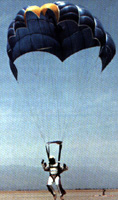 During the early space projects, Rogallo developed a single membrane flexible wing, known as the parawing. The large parawings designed for recovery of reentry vehicles did not have reliable opening characteristics at high speeds and were not used in the actual manned flights. There are several review articles describing the subsonic deployment and control of parawings. The parawing parachute, designed for maximum lift as opposed to maximum drag, was primarily used in sport parachuting during the 1970's.
During the early space projects, Rogallo developed a single membrane flexible wing, known as the parawing. The large parawings designed for recovery of reentry vehicles did not have reliable opening characteristics at high speeds and were not used in the actual manned flights. There are several review articles describing the subsonic deployment and control of parawings. The parawing parachute, designed for maximum lift as opposed to maximum drag, was primarily used in sport parachuting during the 1970's.
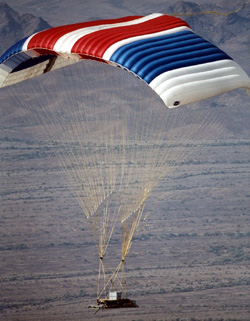 By the late 1970's the parawing was replaced by the parafoil, invented in the middle 1960's by Domina Jalbert, a kite maker. The parafoil or ram-air parachute is a deformable airfoil that maintains its profile by trapping air between two rectangularly shaped membranes, sewn together at the trailing edge and sides, but open at the leading edge. Several ribs are sewn to the inside of the upper and lower surfaces, maintaining an airfoil cross section in the spanwise direction. Stabilizers are added to prevent side slipping. Most personnel ram-air parachutes have a nominal aspect ratio of two and a forward speed of 25 to 30 mph. Dynamic stalls may be performed with a ram-air so that landings are made with zero velocity. The ram-air may also be flown backwards by deflecting the trailing edge past the stall configuration. The parawing and parafoil are hybrids of maximum drag decelerators and rigid wing technology. The vastly superior maneuverability of a ram-air parachute makes it one of the most promising decelerators. The deployment of ram-air parachutes at high speeds tends to degrade or destroy the parachute components. As suitable methods of reefing and staging of deployment are developed the ram-air parachute may have unlimited use.
By the late 1970's the parawing was replaced by the parafoil, invented in the middle 1960's by Domina Jalbert, a kite maker. The parafoil or ram-air parachute is a deformable airfoil that maintains its profile by trapping air between two rectangularly shaped membranes, sewn together at the trailing edge and sides, but open at the leading edge. Several ribs are sewn to the inside of the upper and lower surfaces, maintaining an airfoil cross section in the spanwise direction. Stabilizers are added to prevent side slipping. Most personnel ram-air parachutes have a nominal aspect ratio of two and a forward speed of 25 to 30 mph. Dynamic stalls may be performed with a ram-air so that landings are made with zero velocity. The ram-air may also be flown backwards by deflecting the trailing edge past the stall configuration. The parawing and parafoil are hybrids of maximum drag decelerators and rigid wing technology. The vastly superior maneuverability of a ram-air parachute makes it one of the most promising decelerators. The deployment of ram-air parachutes at high speeds tends to degrade or destroy the parachute components. As suitable methods of reefing and staging of deployment are developed the ram-air parachute may have unlimited use.
[Products] | [Services]
[Join Our Mailing List] | [Advertise on ParachuteHistory.com]
[ ]
[Disclaimer] | [Privacy Policy] | [About]